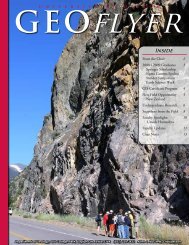Stander Symposium abstract book - University of Dayton
Stander Symposium abstract book - University of Dayton
Stander Symposium abstract book - University of Dayton
Create successful ePaper yourself
Turn your PDF publications into a flip-book with our unique Google optimized e-Paper software.
POSTER SESSION 1<br />
Hippo signaling controls Dronc activity to regulate organ size in Drosophila.<br />
Presenter(s): Aidan Fenix, Shilpi Verghese<br />
Advisor(s): Shimpi Bedi, Madhuri Kango-Singh<br />
Biology - Graduate Research<br />
The Hippo signaling pathway regulates organ size by simultaneously inhibiting cell proliferation and promoting apoptosis. The Hippo pathway is<br />
composed <strong>of</strong> a highly conserved core kinase cascade that is regulated by multiple upstream inputs and has multiple transcriptional outputs. Hippo<br />
signaling is required for cells to stop proliferation when organs have reached their proper size and hippo mutant animals produce severely overgrown<br />
structures. In contrast, over-expression <strong>of</strong> Hippo (or loss <strong>of</strong> yki) results in formation <strong>of</strong> smaller organs due to induction <strong>of</strong> apoptosis. Hippo<br />
pathway regulates apoptosis through its apoptotic target genes e.g., Hid, DIAP1 and the microRNA bantam. We found that cell death induced<br />
by Hippo over-expression cannot be rescued by co-expression <strong>of</strong> pan caspase inhibitor p35 or DIAP1. Hence, we investigated the role <strong>of</strong> Dronc in<br />
Hippo mediated cell death, as Dronc activity is resistant to p35 and not affected by changes in DIAP1 levels. We found that Hippo genetically interacts<br />
with Dronc and requires dronc to induce cell death. Our data suggests Hippo pathway can regulate cell death through the RHG proteins and via<br />
Dronc. Dronc along with its binding partner Dark can suppress the over-growth induced by over-expression <strong>of</strong> Yki, suggesting that normally Hippo<br />
pathway needs to restrict Dronc activity to maintain tissue homeostasis. Consistent with this idea, we found the Hippo pathway transcriptionally<br />
regulates dronc. Loss <strong>of</strong> dronc results in cell survival and dronc mutant cells proliferate faster than their wild-type twin spots. Here we present<br />
dronc (a gene required for cell competition and for caspase-mediated cell death) as a novel target <strong>of</strong> Hippo signaling.<br />
Identifying cis-regulatory element changes that underlie gene expression and phenotypic<br />
evolution between species<br />
Presenter(s): William A Rogers, Joseph R Salomone<br />
Advisor(s): Thomas M Williams<br />
Biology - Independent Research<br />
Contributing substantially to the diversity <strong>of</strong> animal life on Earth are differences in regulatory DNA, particularly in cis-regulatory elements (CREs)<br />
that contain information about where, when, and to what level genes are expressed. The variation in abdominal pigmentation in fruit fly species<br />
provides a model to study both the evolution <strong>of</strong> CREs and the gene expression patterns they control. The bric-a-brac (bab) locus codes for the Bab1<br />
and Bab2 proteins that are repressors <strong>of</strong> abdominal pigmentation development. In the species Drosophila melanogaster, pigmentation and Bab<br />
expression are sexually dimorphic due to the activity <strong>of</strong> a CRE called the dimorphic element. As abdominal pigmentation patterns vary between<br />
related species, our overarching hypothesis is that these phenotypic differences stem from changes in Bab expression via modifications to the<br />
dimorphic element. To test this hypothesis we are studying 4 related species with different abdominal pigmentation by evaluating for each their<br />
Bab1 and Bab2 expression and (2) testing the regulatory capability <strong>of</strong> their dimorphic element. Moreover, to understand how modern dimorphic<br />
element activities evolved we used a sequence comparisons and the parsimony principle to derive the ancestral dimorphic element sequences,<br />
which we have resurrected to evaluate their gene regulatory capability. Future studies will evaluate chimeric CREs <strong>of</strong> ancestral and extant dimorphic<br />
elements to find the mutations responsible for the evolved Bab expression patterns.<br />
Induction <strong>of</strong> Chromatin Remodeling using Histone Deacetylase Inhibitors to Study Role <strong>of</strong><br />
Oct4 in Notophthalmus viridescens (Newt) Eye Regeneration.<br />
Presenter(s): Rital B Bhavsar<br />
Advisor(s): Panagiotis A Tsonis<br />
Biology - Graduate Research<br />
Notophthalmus viridescens (Newts) are capable <strong>of</strong> regenerating many <strong>of</strong> its body parts and organs. They are the only salamander species that<br />
exhibit regeneration <strong>of</strong> lens during adulthood. The lost lens is regenerated by transdifferentiation <strong>of</strong> the pigmented epithelial cells to lens cells.<br />
This kind <strong>of</strong> cell type conversion is thus a natural potency <strong>of</strong> this organism. Whereas, in vitro cell type conversion studies are observed during<br />
direct reprogramming where one cell type is converted to another cell type using a cell type specific transcription factor along with histone<br />
deacetylase inhibitors. In this study, we proposed to compare the mechanisms <strong>of</strong> transdifferentiation during Newt lens differentiation and in vitro<br />
27

















